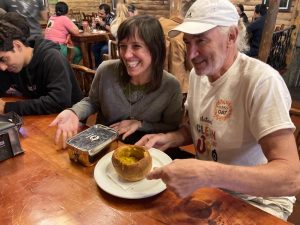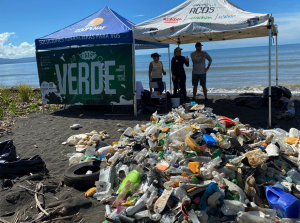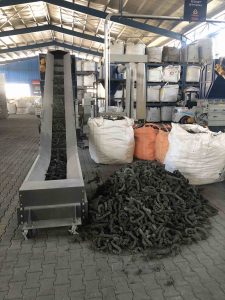International connections
The International Dialogue that I attended in Costa Rica, is an undertaking of the Zero Waste International Alliance (ZWIA). ZWIA is made up of affiliate organisations (ZWN is one!) and is also a network of amazing zero waste practitioners.

This was why I was so excited to attend the Dialogue – the theme of which was Global Challenges and Best Practices from Around the World – to get to meet and hang out with some of world’s finest zero waste thinkers and innovators. Speakers came from far and wide – Sweden, Canada, Europe, Philippines, Columbia, as well as a very impressive contingent from the United States. A couple of years ago we had started work on hosting ZWIA for an in person event here in Aotearoa, but the pandemic firmly quashed that idea and we ended up running the Our Zero Waste World Summit instead. Many of the people who traveled to Costa Rica had generously joined us online for the Summit, and it was a real pleasure to connect in person. Spending time with Jamie Kaminsky from Zero Waste Canada was particularly enlightening – it seems like our two countries have lots of similarities, and it was really useful to get Jamie’s take on things like Extended Producer Responsibility, and to hear about the kinds of strategies that are making municipalities in Canada move away from Waste Incineration. Zero Waste Canada have a Zero Waste Facilities Certification programme up and running, and are looking at developing a similar programme for Zero Waste cities. This is a piece of work I think has relevance for us here in Aoteaora and I am continuing to work with Jamie on this.
Pervasive plastic
Before the conference officially started, I met some of the Zero Waste Costa Rica and ZWIA crew in a lovely beach town called Manuel Antonio (I could write a whole section on all the cool animals I saw while I was there, but will keep it to a list: sloths, tucans, gangs of monkey’s and scarlet macaws, HUGE lizards and crabs, freaky insects, owls). The scenery and the beach town vibe was all enough of a reason to be there, but there was some serious zero waste business to be done too. Half the crew stayed in town to support waste minimisation efforts at the Triathlon Quepos, while the other half traveled up the coast to Guacalillo beach, which has the unfortunate title of being the most polluted beach in Costa Rica. It sits at the mouth of the river that flows down from the Costa Rican highlands and brings with it waste from upstream, including Costa Rica’s biggest city and capital, San Jose.

I was part of this team, and we joined 35 local volunteers who had collected hundreds of of items of shore waste. Led by Victor Arce from a local organisation that encourages surfers to take care of their beaches and Daniela Ochoa, from Regenerative Solutions, we undertook a brand audit using the #breakfreefromplastic format and methodology. Out of a 114.7 kg sample, we identified and quantified items in 6 categories and then also classified them by brand. Once entered in the data sheet, all items were weighed. PET constituted 52.7% of the collection: bottles of coke, bicola, guaro, pepsi, and bic lighters were the top five brands identified, in that order. The other more prominent item were shoes, although most of them had unidentifiable brands.

It was a really interesting process – I’ve done a lot of beach clean ups, and audits but never a brand audit – and it was fascinating to see the piles of materials and realise that for the most part, these were the same brands I see here at home. The other thing that was overwhelmingly obvious, it was mostly plastic.
The next day, back in San Jose, we had another plastic focused experience. We were hosted by Donald Thomson, CEO and Founder of CRDC and David Zamora from Pedregal at the Resin8 plant. This plant produces a plastic resin out of recycled plastic that is then used in construction materials. Their initial focus had been on using ‘tragic plastic’ – plastic captured from the ocean – but now utilise any type of plastic waste (Resins 1-7) as its main component. I appreciated the opportunity to see the plant, and the process, however I felt uneasy about some of the background information I was hearing about the increasing interest the oil industry has in the plastics industry. Apparently, the petroleum industry nexus is shifting from petrol to plastics and I felt super disheartened about the idea of the power and the money associated with the petroleum industry moving to support products we know with such certainty are polluting, and for which we also know there are many alternatives too – we just need to follow the waste hierarchy. I felt a bit better after I talked to the ZWN team over zoom and Hannah talked about some of the awesome work happening around a plastics treaty.
Zero Waste Costa Rica
It was a pleasure to meet Annemarie Sauter and Elena Mateo, the co-directors of Zero Waste Costa Rica, and inspiring to understand their journey in setting up this ZWIA national affiliate. They have a number of arms to their activities, including working with schools and delivering the “On the Road to Zero Waste” certification recognition, and the Dialogue itself was testament to the kinds of impact they are having in creating a zero waste culture. Representatives from all aspects of Costa Rican society attended, including central and local government, businesses – large and small – including the waste sector and the tourism sector, academics and the nonprofit sector. This broad and engaged network of people has been built in just a few years, since the establishment of Zero Waste Costa Rica in 2019. This led me to reflect on the opportunities that living in a small country such as Costa Rica, but also Aotearoa, brings for creating mindset shifts. It is something that is easy to lose sight of in the slog of trying to create change, but something I need to remember not to take for granted. Overall, the waste sector in Aotearoa is connected and easy to navigate.
Innovative Economic Models
Two interesting ideas and programmes made me consider the role of financial incentives in getting good resource recovery outcomes. The first was a Costa Rican project called ecoins ecoins. During the Dialogue ecoins Director Karla Chavez explained the ecoins model – which is essentially a product stewardship scheme, in which the consumer takes responsibility for taking care of the product so that it can be returned for recycling. In exchange for recovering and delivering “Limpio, seco, separado” (Clean, dry and separated” items for recycling, participants receive ecoins that can be exchanged for discounts on products and experiences from participating companies.123,000 families are already participating in the ECOINS programme and making use of its 450 exchange points. There’s lots about this programme that interests me, particularly the use of gamification to make it an attractive platform to use, especially for children. Multiple incentives and hooks to use the programme seem important because the ask of the consumers /participants in terms of actions they need to undertake are significant. It also interested me that part of the pitch for why companies should get involved, is centred around gaining access to market data.
The second project is a new initiative from Basura Cero Global, based in Colombia, and operating throughout Central and South America. Sandra Pinzón, Director of Basura Cero Global, is working on launching a new global voluntary program for the circular economy of materials, which issues credits for plastics and thereby finances the promotion of solutions in solid waste management.
A plastic credit is a lot like a carbon credit, purchased by companies that use plastic in their operations, and want to mitigate this plastic footprint. The money collected is used to invest in projects that help collect and recycle plastic waste.
Both of these programmes have a strong volunteer aspect to them – consumers and companies choose to be involved. This differs from the path Aotearoa is slowly going down towards mandatory product stewardship and while I remain strongly in favour of stewardship being regulated, it was still really valuable to understand how voluntary models can be delivered at scale and what is required to make them effective.
Environmental Justice
Finally, a presentation from Dennis Uyat Franco on Environmental Racism and Environmental Justice, shared how in the United States Indigenous, Black, and Migrant Communities take on more environmental burdens than white communities. Often this looks like the siting of activities and infrastructure that are known to cause toxic waste in proximity to these communities, and away from majority white communities. Dennis highlighted examples of environmental racism in the huge number of abandoned uranium mines across the Navajo Nation, and Cancer Alley in Louisiana. For a short introduction to the concept of Environmental Justice, check out this video: https://www.weforum.org/videos/19034-environmental-racism-explained.
The presentation reminded me of the conversations we have been having in Aotearoa about waste colonialism (the practice of exporting waste from developed countries -yep, that’s us Aotearoa – to underdeveloped ones for disposal). For a good academic article about Aoteaora’s role check out this paper: jpe-2401-fuller (1).pdf (736.6Kb)
Also linked, is the role of Aotearoa’s colonial history in the widespread replacement of traditional Māori waste (and resource) management practices with colonial ones, based on the exploitation of resources. As Para Kore’s submission to MfE’s Waste Strategy consultation in 2021 summarised “Colonial systems derive their power and wealth from the exploitation and theft of resources from indigenous peoples. Māori land and resources were alienated by colonisers to form the basis of the settler economy and advance capitalist endeavours”.
All of this is a good reminder that there are many aspects of a zero waste future that should be as much about people, justice and fairness, as about the environment.


